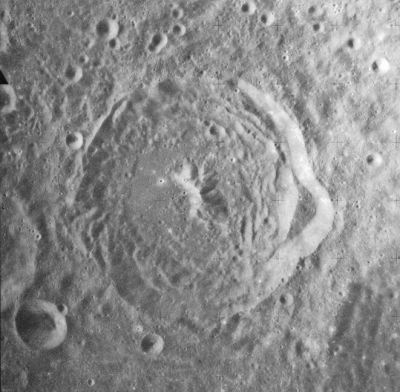Green
Contents
[hide]Green
| Lat: 4.1°N, Long: 132.9°E, Diam: 65 km, Depth: km, Rükl: (farside) |
Images
LPOD Photo Gallery Lunar Orbiter Images Apollo Images
- Apollo 11's AS11-36-5416 shows a shadowless Green near the centre of this orbital Hasselblad. Looking east-northeast. The curious "cubic" object near the image's lower right corner is part of LM Eagles Ascent Stage. Compare this photograph with the lower left corner of LAC 66 ('Green and its east-northeastern environs) on page 132 of the Clementine atlas.
- The chaotic floor and bright inner slopes of Green M (south of Green itself) were captured on Apollo 10's AS10-28-4001, 4002, and 4003.
- Green M was also captured on AS10-33-4870.
- A wonderful reproduction of Apollo 11's orbital Hasselblad frame AS11-40-5844 (craters Green and Hartmann) is seen on page 195 of Norman Mailer's book MOONFIRE, THE EPIC JOURNEY OF APOLLO 11. Because of contrast-enhancement, both craters are very well noticeable, which isn't the case on the original Hasselblad film (no shadows due to the sun's altitude).
- Additional research orbital Apollo photography: Danny Caes
Maps
(LAC zone 66D1) USGS Digital Atlas PDF
IAU page: Green
Description
Description: Wikipedia
Additional Information
- Exterior impact melt deposits on a 35 km diameter crater S of Green, with most extensive deposits to NNW, max of ~1 km beyond rim (Hawke and Head, 1977).
- TSI = 25, CPI = 15, FI = 2o; MI =60 Smith and Hartnell, 1973
Nomenclature
- Named for George Green (July 14, 1793 – May 31, 1841), a British mathematician and physicist, who wrote an essay that introduced several important concepts, among them a theorem similar to the modern Green's theorem, the idea of potential functions as currently used in physics, and the concept of what are now called Green's functions. In his adult life, Green worked in his father's mill, taking ownership upon his father's death in 1829. At some point, he began to study mathematics. As Nottingham had little in the way of intellectual resources, it is unclear to historians exactly where Green obtained information on current developments in mathematics. On a visit to Nottingham in 1930, Albert Einstein commented that Green had been twenty years ahead of his time.
- Perhaps interesting to know: there was once another Green on the moon (at the near side's western limb region). This Green was one of Percy Wilkins's "new" names which appeared in his book The Moon (Wilkins/ Moore). Samuel Morris Green (1920-1942) seems to have been an English lunar observer who died too young.
- There was also an observer of Mars, Nathaniel E. Green, of which his map of Mars is included in William Sheehan's book Planets and Perception; telescopic views and interpretations, 1609-1909. See also bibliography below (N.E.Green in the Sourcebook Project).
LPOD Articles
Bibliography
Nathaniel E. Green in the Sourcebook Project (William R. Corliss)
Page 436 in Mysterious Universe, a handbook of astronomical anomalies (1979) :
- Another Red Spot on Jupiter (Nathaniel E. Green, Astronomical Register, 1885).
